Essential EV Battery Minerals: A Simple Guide
Electric car batteries rely on specific minerals for power and longevity. Key elements like lithium, cobalt, nickel, manganese, and graphite are vital. Understanding these minerals helps appreciate EV technology and its future.
What Minerals Are Needed: Essential EV Battery Insights
Thinking about an electric car? You’ve probably heard a lot about how they run on batteries. But what makes these batteries tick? It might surprise you to learn that they’re made up of some pretty common, yet incredibly important, minerals. These aren’t just any rocks; they are the powerhouses that let your EV drive quietly and cleanly down the road. Without them, electric cars as we know them wouldn’t exist. In this guide, we’ll break down exactly which key minerals are needed for these amazing batteries. We’ll keep it super simple, so you can understand what’s inside your electric car’s energy source. Ready to dive into the fascinating world of EV battery ingredients?
The Building Blocks of Electric Power: Key Battery Minerals
Electric car batteries, often called EV batteries, are sophisticated pieces of technology. At their heart, they are energy storage units that use chemical reactions to store and release electricity. The types of minerals used can greatly affect a battery’s performance, how long it lasts, and even how much it costs. Think of it like baking a cake – the type and quality of your ingredients make a big difference to the final product. For EV batteries, there’s a handful of minerals that are truly essential. Let’s take a closer look at the stars of the show.
Lithium: The Energizer Bunny
If there’s one mineral you’ve likely heard of in relation to EV batteries, it’s lithium. It’s the main ingredient in the most common type of EV battery, known as a lithium-ion battery. Lithium is incredibly light and has a high electrochemical potential, meaning it can store and release a lot of energy for its weight. This makes it perfect for giving electric cars the range they need to be practical for everyday driving and longer trips.
Lithium is typically extracted from brines found in underground reservoirs, often in desert regions like South America’s “Lithium Triangle” (Chile, Argentina, and Bolivia). It can also be mined from hard rock deposits, like those found in Australia. The process involves pumping brine into large evaporation ponds or carefully extracting rock to process the lithium out. This mineral is crucial for the battery’s ability to hold a charge and deliver power efficiently.
Why it’s important:
- Enables high energy density, meaning more power in a smaller, lighter battery.
- Allows for fast charging and discharging of energy.
- Contributes to the overall lifespan of the battery.
Cobalt: The Stabilizer
Cobalt is another critical mineral, often used in conjunction with nickel and manganese in the cathode (the positive electrode) of lithium-ion batteries. Its main job is to stabilize the battery’s structure, allowing it to handle many charge and discharge cycles without degrading too quickly. Cobalt also helps increase the battery’s energy density, meaning it can store more electricity for its size.
The majority of the world’s cobalt supply comes from the Democratic Republic of Congo (DRC). Mining cobalt can be complex, and ethical sourcing is a growing concern in the industry. Battery manufacturers are actively researching and developing new battery chemistries that use less cobalt or are cobalt-free, aiming to reduce reliance on this particular mineral while still maintaining high performance and safety standards. Some of these advancements include high-nickel cathodes.
Cobalt’s role:
- Improves battery stability and cycle life.
- Boosts energy density.
- Enhances safety by preventing overheating.
Nickel: The Power Booster
Nickel is prized for its ability to increase a battery’s energy density. Batteries with higher nickel content can store more energy, which translates to longer driving ranges for electric vehicles. It’s often combined with lithium, cobalt, and manganese in different proportions to create various types of lithium-ion battery cathodes, such as Nickel-Manganese-Cobalt (NMC) or Nickel-Cobalt-Aluminum (NCA).
As battery technology evolves, manufacturers are increasing the amount of nickel in battery cathodes. This trend aims to reduce the need for cobalt and improve overall battery performance. Major nickel-producing regions include Indonesia, the Philippines, and Russia. Sourcing nickel sustainably and responsibly is an ongoing focus for the EV industry.
Nickel’s contribution:
- Significantly ups the energy storage capacity.
- Allows for longer driving distances on a single charge.
- Is a key component in many advanced battery designs.
Manganese: The Cost-Saver and Stabilizer
Manganese is often paired with nickel and cobalt in battery cathodes. It’s valuable because it’s relatively abundant and less expensive than cobalt, making it a great component for balancing cost and performance. Manganese helps to improve the safety and stability of the battery, especially at higher temperatures.
By using manganese, manufacturers can reduce the amount of more expensive minerals like cobalt needed in a battery. This makes EV batteries more affordable and accessible. South Africa, Australia, and China are among the top producers of manganese globally. Its inclusion in battery chemistries is a smart move towards creating more economical and resilient EVs.
Manganese’s benefits:
- Helps lower the overall cost of the battery.
- Improves battery safety and thermal stability.
- When used in specific configurations, can enhance lifespan.
Graphite: The Conductor
While lithium gets most of the spotlight for the cathode, graphite plays a vital role in the anode (the negative electrode) of most lithium-ion batteries. Graphite is a form of carbon that is excellent at conducting electricity. During charging, lithium ions move from the cathode to the anode and are stored within the graphite structure.
When you drive, the lithium ions move back to the cathode, releasing energy. Natural graphite is mined in several countries, with China being the largest producer. Synthetic graphite, made through industrial processes, is also used. The quality and structure of the graphite anode are crucial for how quickly a battery can charge and discharge, as well as its overall energy storage capacity.
Graphite’s function:
- Forms the anode where lithium ions are stored.
- Facilitates fast charging and discharging.
- Is essential for the battery’s ability to cycle energy.
Beyond the Big Five: Other Important Minerals
While lithium, cobalt, nickel, manganese, and graphite are the most talked-about minerals, EV batteries often contain other elements and materials that are important for their function and longevity. These include:
- Aluminum: Used in the current collectors for both the anode and cathode, helping to conduct electricity within the battery.
- Copper: Also used as a current collector, particularly for the anode, and sometimes in the wiring that connects battery cells.
- Iron: Can be used in certain battery chemistries, like Lithium Iron Phosphate (LFP), which is becoming increasingly popular for its safety and lower cost. LFP batteries do not contain cobalt or nickel.
- Phosphorus: A key component in LFP batteries, offering a more stable and sustainable alternative.
The exact mix of minerals can vary depending on the specific type of battery. For example, LFP batteries have largely replaced cobalt and nickel with iron and phosphorus, making them an excellent choice for electric vehicles where extreme long-range performance isn’t the top priority, but safety and cost are.
The Journey of These Minerals: From Earth to Battery
The minerals needed for EV batteries have a long journey from their natural sources to becoming part of the high-tech battery in an electric car. This process involves several stages:
- Extraction: Minerals are mined from the earth. This can involve digging open-pit mines for hard rock minerals or pumping brine from underground reservoirs.
- Processing: The raw ore or brine is treated to concentrate the desired mineral. This often involves chemical processes to separate the valuable elements from impurities.
- Refining: The concentrated mineral is purified further to reach the high-grade quality needed for battery manufacturing. This is where materials like lithium carbonate or lithium hydroxide are produced.
- Material Production: Refined minerals are then converted into specific battery materials. For example, lithium, nickel, cobalt, and manganese are processed into cathode active materials, while graphite is prepared for anode use.
- Battery Cell Manufacturing: These materials are then used by battery manufacturers to create the individual battery cells, which are eventually assembled into battery packs for electric cars.
This entire supply chain is complex and global. Ensuring a stable and ethical supply of these minerals is a top priority for the automotive and battery industries. For more details on raw material sourcing, you can refer to resources from organizations like the U.S. Department of Energy, which tracks battery research and supply chains.
EV Battery Chemistries: What Minerals Mean for Performance
The specific combination of minerals used in an EV battery – its “chemistry” – directly influences its capabilities. Different chemistries are suited for different needs. Here’s a look at some common types and their mineral makeup:
| Battery Chemistry | Key Minerals | Pros | Cons |
|---|---|---|---|
| Lithium-Nickel-Manganese-Cobalt (NMC) | Lithium, Nickel, Manganese, Cobalt | High energy density (long range), good performance in various temperatures. | Higher cost due to cobalt, can be less stable than other types. |
| Lithium-Nickel-Cobalt-Aluminum (NCA) | Lithium, Nickel, Cobalt, Aluminum | Very high energy density, good power output. | Higher cost, requires careful thermal management. |
| Lithium Iron Phosphate (LFP) | Lithium, Iron, Phosphorus | Lower cost, excellent safety, long cycle life, no cobalt or nickel. | Lower energy density (shorter range per pound), performance can be affected by very cold temperatures. |
| Lithium-Manganese Oxide (LMO) | Lithium, Manganese | Good power capability, improved safety over some other types. | Lower energy density compared to NMC or NCA. |
As you can see, the mineral choices allow manufacturers to tailor batteries for specific vehicle types and driver preferences. For instance, automakers looking to offer more affordable EVs might opt for LFP batteries, while those focused on performance and maximum range might choose NMC or NCA. The ongoing research aims to find chemistries that offer the best balance of range, cost, safety, and sustainability.
The Importance of Battery Recycling and Sustainability
The increasing demand for EV batteries brings a spotlight onto the sustainability of mineral sourcing. Mining these essential minerals can have environmental impacts, and securing enough supply for the future is a challenge. This is why battery recycling and the development of new, less resource-intensive battery technologies are so important.
Recycling Benefits:
- Reduces mining: Reclaiming valuable minerals from old batteries means less new mining is needed. This conserves natural resources and reduces habitat disruption.
- Lower carbon footprint: Recycling can often require less energy than extracting and processing new raw materials.
- Circular economy: It helps create a closed-loop system where materials are reused, making the EV industry more sustainable in the long run.
Companies are developing advanced recycling processes to efficiently recover lithium, cobalt, nickel, and other valuable metals from end-of-life EV batteries. Organizations like the U.S. Environmental Protection Agency (EPA) provide information on recycling initiatives and their importance.
Furthermore, research is ongoing into “next-generation” battery technologies. These might use more abundant materials, be more energy-dense, or have even longer lifespans, further reducing reliance on scarce or ethically challenging minerals. Solid-state batteries, for example, are a promising area that could potentially reduce or eliminate the need for some of the critical materials used today.
Frequently Asked Questions About EV Battery Minerals
Q1: What is the most important mineral in an EV battery?
A1: Lithium is often considered the most important mineral because it’s the core component that allows the battery to store and release energy in lithium-ion batteries. Without lithium, these batteries wouldn’t function as we know them.
Q2: Are all EV batteries the same?
A2: No, EV batteries come in different “chemistries,” which means they use slightly different combinations of minerals in their cathodes and anodes. Common types include NMC, NCA, and LFP, each with its own strengths and weaknesses.
Q3: Where do the minerals for EV batteries come from?
A3: These minerals are mined from deposits around the world. Lithium often comes from brine evaporation ponds in South America or hard rock mines in Australia. Cobalt is predominantly sourced from the Democratic Republic of Congo, while nickel has major supplies from Indonesia and the Philippines. Graphite is largely from China.
Q4: Is mining these minerals bad for the environment?
A4: Mining can have environmental impacts, including water usage, land disruption, and potential pollution. However, the industry is working on more sustainable extraction methods and increasing battery recycling to reduce these impacts. The environmental benefits of EVs compared to gasoline cars are still significant over their lifetime.
Q5: Will there be enough minerals for all the electric cars?
A5: This is a big question! Demand is growing rapidly. While there are vast reserves of these minerals, ensuring consistent and ethical supply chains, along with effective recycling, is crucial. Companies and governments are investing heavily in battery production and material sourcing.
Q6: Can I replace minerals in my car battery myself?
A6: No, EV batteries are complex, sealed units. The minerals are integral to the battery’s internal chemistry and are assembled in a factory. For any battery issues, always consult a qualified EV technician or the dealership.
Conclusion: The Future is Powered by These Essential Minerals
Understanding the minerals that power electric vehicles gives us a clearer picture of this exciting technology. From lithium’s energy-rich properties to graphite’s conductive role, each mineral plays a vital part in making EVs a reality. While challenges exist in sourcing and sustainability, the industry is actively innovating. Advances in battery chemistry, increased recycling efforts, and a focus on ethical sourcing are paving the way for a cleaner, greener automotive future. As EV adoption continues to grow, so too will the importance of these essential battery minerals and the technologies that make their use as efficient and responsible as possible. So next time you see an EV gliding down the street, you’ll have a better appreciation for the incredible science and the fundamental minerals that make it all possible!




